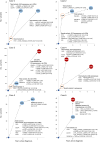Primary thyroid B-cell lymphoma: molecular insights into its clonal evolution and relapse
- PMID: 39722652
- PMCID: PMC11717488
- DOI: 10.1002/path.6380
Primary thyroid B-cell lymphoma: molecular insights into its clonal evolution and relapse
Abstract
Primary thyroid lymphomas comprise largely extranodal marginal zone lymphoma of mucosa-associated lymphoid tissue (EMZL) and diffuse large B-cell lymphoma (DLBCL), followed by follicular lymphoma (FL). They commonly develop from a background of Hashimoto's thyroiditis (HT), where dysregulated immune responses trigger autoreactive infiltrates and drive clonal B-cell evolution. To understand how these lymphomas and their relapse evolve, we investigated 10 cases by mutation profiling, including five with metachronous lymphomas [primary lymphoma (EMZL = 4, DLBCL = 1) with local relapse (EMZL = 3, DLBCL = 2)], one composite EMZL and Epstein-Barr virus (EBV)-positive DLBCL, and four lymphomas (EMZL = 3, FL = 1) with prior or subsequent biopsy showing HT. In four cases with metachronous lymphomas, both common and distinct variants were seen in the paired lesions, indicating their divergent evolution from clonally related lymphoma precursor (CLP) cells. In the remaining case with metachronous lymphomas, the relapsed lesion was progressed from the initial lymphoma. In the case with composite lymphoma, the EBV-positive DLBCL was transformed from EMZL. Finally, in the four cases with paired lymphoma and HT biopsies, two showed shared mutations between the paired lesions, indicating involvement and divergent evolution from CLP cells. Thyroid lymphoma relapse may frequently develop via divergent evolution from a CLP cell, which is likely premalignant. © 2024 The Author(s). The Journal of Pathology published by John Wiley & Sons Ltd on behalf of The Pathological Society of Great Britain and Ireland.
Keywords: Hashimoto's thyroiditis; clonal evolution; lymphoma relapse; mutation profile; thyroid lymphoma.
© 2024 The Author(s). The Journal of Pathology published by John Wiley & Sons Ltd on behalf of The Pathological Society of Great Britain and Ireland.
Figures



Similar articles
-
Divergent evolution of metachronous follicular lymphoma and extranodal marginal zone lymphoma of mucosa-associated lymphoid tissue from a common precursor.J Pathol. 2023 Sep;261(1):11-18. doi: 10.1002/path.6143. Epub 2023 Jun 22. J Pathol. 2023. PMID: 37345526 Free PMC article.
-
[Primary lymphomas in urinary bladder: a clinicopathological analysis of 23 cases].Zhonghua Bing Li Xue Za Zhi. 2025 Sep 8;54(9):925-931. doi: 10.3760/cma.j.cn112151-20241221-00862. Zhonghua Bing Li Xue Za Zhi. 2025. PMID: 40921666 Chinese.
-
Genetic Profiling Reveals the Distinctions Among MTX-Associated DLBCL, EBV-Positive Mucocutaneous Ulcer, and EBV + DLBCL.Cancer Sci. 2025 Aug;116(8):2306-2316. doi: 10.1111/cas.70111. Epub 2025 Jun 3. Cancer Sci. 2025. PMID: 40458922 Free PMC article.
-
Chimeric antigen receptor (CAR) T-cell therapy for people with relapsed or refractory diffuse large B-cell lymphoma.Cochrane Database Syst Rev. 2021 Sep 13;9(9):CD013365. doi: 10.1002/14651858.CD013365.pub2. Cochrane Database Syst Rev. 2021. PMID: 34515338 Free PMC article.
-
Epstein-Barr virus-positive, primary cutaneous marginal zone lymphoma, with transformation: Case report and review of the literature.Am J Clin Pathol. 2025 Feb 12;163(2):298-312. doi: 10.1093/ajcp/aqae124. Am J Clin Pathol. 2025. PMID: 39290045 Review.
References
Publication types
MeSH terms
Grants and funding
LinkOut - more resources
Full Text Sources
Medical
Molecular Biology Databases
Miscellaneous

